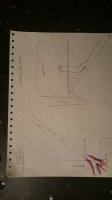onelilypad
New Member
We are up for a water test inspection of our addition. Since the entire 180 sq foot addition is a DIY, I want to confirm a few things (after spending hours on this forum!) before we jump into this: All of our underground plumbing is located within our slab foundation. Because of this, no test tee was installed as it would also be in concrete. Our current options to complete the water test are:
A. Use a long test ball to plug the main drain from the cleanout - requiring removal of the toilet, shower drain, etc of the existing bathroom and kitchen to insert test plugs/balls.
B. Jackhammer the new concrete (and cut rebars!) in the exact location where a test tee SHOULD be (between the main drain and new addition), insert test tee, run water test, do inspection and fill up with concrete again.
C. Jackhammer the concrete just upstream of the cleanout and install a test tee, slide a test ball upstream to isolate just the addition, run test and backfill with more concrete.
D. Somehow place a test ball in the correct spot 6 feet from the nearest opening (in this case, a toilet pipe), inflate test ball, fill with water, seal opening with air tube extension sticking out and magically remove the test ball without breaking anything.
Realistically, I think option A is our only REAL option but I'd love to hear your opinions on this. If I'm right, and we go with option A, can we use mechanical test plugs in the sink, shower, toilet areas? I believe that the test balls need to remain connected to a pump to remain inflated - is that correct? We have ONE auto air pump that we will have connected to the long test ball for the cleanout. Some of the test plugs can only hold 5 feet of back pressure but I was able to find a few online that can hold 40 or 50 - I'm assuming the the 40'head of water is more than enough for my single story home.
Pic for clarification.
Thanks in advance
A. Use a long test ball to plug the main drain from the cleanout - requiring removal of the toilet, shower drain, etc of the existing bathroom and kitchen to insert test plugs/balls.
B. Jackhammer the new concrete (and cut rebars!) in the exact location where a test tee SHOULD be (between the main drain and new addition), insert test tee, run water test, do inspection and fill up with concrete again.
C. Jackhammer the concrete just upstream of the cleanout and install a test tee, slide a test ball upstream to isolate just the addition, run test and backfill with more concrete.
D. Somehow place a test ball in the correct spot 6 feet from the nearest opening (in this case, a toilet pipe), inflate test ball, fill with water, seal opening with air tube extension sticking out and magically remove the test ball without breaking anything.
Realistically, I think option A is our only REAL option but I'd love to hear your opinions on this. If I'm right, and we go with option A, can we use mechanical test plugs in the sink, shower, toilet areas? I believe that the test balls need to remain connected to a pump to remain inflated - is that correct? We have ONE auto air pump that we will have connected to the long test ball for the cleanout. Some of the test plugs can only hold 5 feet of back pressure but I was able to find a few online that can hold 40 or 50 - I'm assuming the the 40'head of water is more than enough for my single story home.
Pic for clarification.
Thanks in advance

